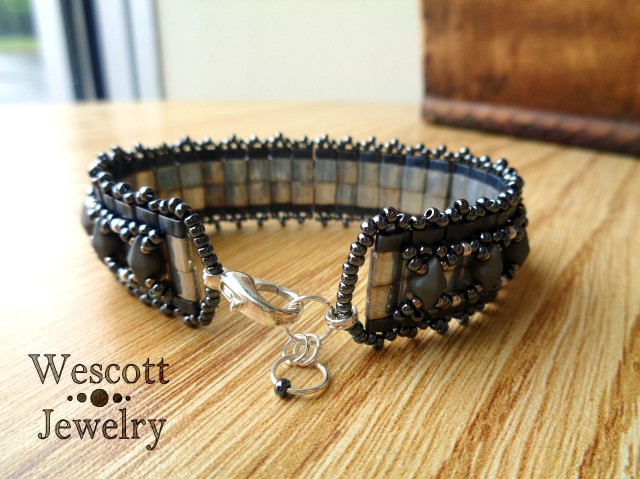I wanna start a new series on this blog where I compare different types of clasps and talk a bit about what I’ve learned over the years in terms of what they are and aren’t good for. I’m calling it the Clasp Wars and today we’re gonna start with one of the most basic clasp types of the all.
The Lobster Claw.
So, you’ve definitely seen this buddy before. It’s a standard clasp that comes on a lot of jewelry, both manufactured and hand-made. You pull the little lever with a finger nail and the claw opens up and allows the clasp to be hooked onto a single ring or a chain. Let’s talk about the Pro’s and Cons of these little guys.
Pro’s
First off, lobster claw clasps are one of the most secure clasp options you can choose. They don’t rely on tension to stay closed, but have an actual locking lever mechanism. They can’t slide off and can usually withstand a pretty fearsome tug. Different lobster claws will have different levels of strength depending on what metal they’re made out of, but in general I consider them to be top tier in terms of security.

Secondly, using a lobster claw clasp is a really easy way to make your jewelry adjustable. This is really useful in a couple different situations. For example, if you sell your jewelry (like I do), making a bracelet adjustable means that you have a wider pool of customers it will fit. It also makes necklace lengths adjustable, which is great when you’re trying to make your necklace sit just right against the neckline of your top or dress.

Plus, I love making adjustable clasps on bracelets and then putting a coordinating bead on the last loop of the chain.

Thirdly, lobster claw clasps are one of the most basic types of clasps, so they are very easy to find. They aren’t some sort of niche finding that you can only find in one or two specialty shops. The ubiquitous nature of lobster claws also means that customers pretty much always know how they work and don’t struggle to figure out how to work the clasp on the pretty bracelet they just bought.

Fourthly, related to them being easy to find, lobster claw clasps come in a variety of styles. You can find them in drastically different sizes, all sorts of finishes and colors, and sometimes with more decorative elements on them. I generally stock up on the simple ones, but lots of more elaborate styles exist. And because there are so many material and color options out there, finding a lobster claw that coordinates with your other findings is usually fairly painless.

Fifthly, I find that the simplicity of lobster claw clasps keeps them from distracting from the rest of your design. Sometimes a big statement clasp is a must and positively makes a piece, but sometimes you wanna add other elements to a project and the simplicity of a lobster claw gives you room to include more details elsewhere. In these custom Ravenclaw themed bracelets, the simple a secure lobster claw was an ideal place to attach these bonus Harry Potter charms.

Cons
The first and biggest problem with lobster claw clasps is that some of them can be hard to use. A low-quality lobster claw might be stiff or have a broken internal spring that keeps the lever from working properly. Even when you have a high quality lobster claw that works smoothly and closes completely, some people struggle to manipulate the little lever. Folks with arthritic hands or people with limited fine motor control can really struggle with that tiny little tab.

Even if the tab isn’t the problem, sometimes you find yourself chasing the rings with the lobster claw around and around your wrist, trying to fasten it without help. For me, I drape the bracelet over my wrist, so that the chain is dangling down and the claw is reaching up to snag it. Then, I press my wrist up against the underside of a table or cabinet, pinning the chain down, and reach up with the clasp to fasten it. If that doesn’t work for you, you might wanna try the paperclip trick!
When Do I Use Them?
For me, lobster claw clasps are a great basic clasp option. Because they are secure, I like to use them for bracelets, especially when I want to add a few rings and a cute dangle to make my piece adjustable.
I really like to use them on slim bracelets in more casual styles because lobster claws come in lots of small sizes that don’t distract from the bracelet or add too much bulk.
They are also great on necklace chains with pendants because making the necklace length adjustable makes it easier to style with different tops and necklines.
The only major downside is that some customers find them difficult to use. You can mitigate this a bit by seeking out smooth, high-quality clasps or using larger sizes, but in the end, some people just avoid lobster claw clasps across the board and you might get a request to change out the clasp.
So! Did you guys find that helpful at all? If so, what style clasp would you like me to discuss next? Comment below and help me decide!



Box clasps? Some of them are really beautiful but I just don’t trust that they will stay closed if there’s any pull on the necklace.
LikeLike
Trailer Hitch Clasp
LikeLike
Use of toggles, please.
LikeLike
Box clasps. I have bought many different types. They are pretty, but sometimes when it’s in a closed package and you can’t try it out, the mechanism doesn’t work well and you are stuck with garbage.
LikeLike
I really love using stainless steel ones with stainless steel split rings
LikeLike
I agree with LindaJill box clasps
LikeLike
Pingback: Clasp Wars: The Box Clasp | Wescott Jewelry